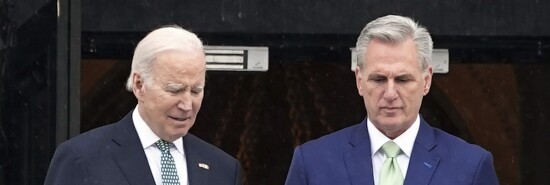
The federal deficit rose by 63% in one year. Why is Biden resisting spending reforms?
Tiana Lowe Doescher
Video Embed
With just a month or so until the U.S. government defaults on its national debt, President Joe Biden has finally agreed to meet with House Majority Leader Kevin McCarthy. Although the California Republican has already succeeded in passing a bill through the House to raise the debt ceiling, Biden has repeatedly said he will not sign any debt ceiling increase that involves spending reform.
Biden would be wise to rethink this stance. Without a drawdown of the federal deficit, a debt ceiling increase would only delay the inevitable. At the government’s current rate of spending competing against inflation, a default on our national debt is a matter of “when,” not “if.”
WHY IS THE NEW YORK TIMES SOFT-LAUNCHING ELIZABETH HOLMES’S REBRAND?
The latest release from the nonpartisan Congressional Budget Office puts it in stark terms. In just the first seven months of fiscal 2023, the federal budget deficit reached almost $1 trillion — a 63% increase from the $568 billion deficit recorded in the first seven months of fiscal 2022. And if not for a few timing quirks that pushed payments for this fiscal year back into the last, the deficit increase would have actually reached 74% from fiscal 2022 to 2023.
Revenue fell by 10% in large part due to an 18% drop in individual income tax paid, whereas corporate and payroll tax revenue actually rose. This is not due to a substantial increase in the number of younger, lower-paid workers. Rather, the Fed has found that more than 2 million boomers retired earlier than the central bank had anticipated. An important reason is the Democrats’ obsession with pursuing “full employment.” This is fueling asset bubbles, prompting baby boomers to cash out of the workforce entirely.
On the other side of the equation, federal spending rose by 8% in the first seven months of the fiscal year. Much of the increase resulted from higher interest costs on paying down the national debt — up 40% thanks to the Fed’s interest rate hikes, again a consequence of inflation. An 11% increase in entitlement spending and 56% increase in Education Department spending, thanks to the $48 billion spent on just the beginning of Biden’s student loan bailout, accounted for much of the rest.
Two things can both be true at once. First, the government does indeed have a responsibility to pay for its spending. And second, a good time to tighten the belt and set a more restrictive budget for the future is when one needs to pay off out-of-control debts.
Despite the pandemic being over and Democrats having already achieved the “full employment” they have always dreamt of, we’re on track to spend nearly $2 trillion this fiscal year. From the cost of borrowing to our dismal labor force participation rate, the federal government has managed to worsen every element on both sides of the equation. The best time may have been 20 years ago, but the second best time to avoid fiscal Armageddon is today.
